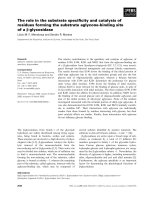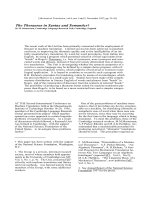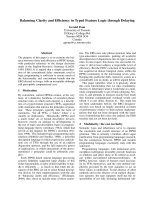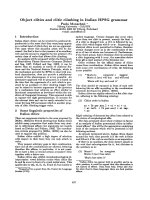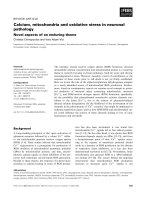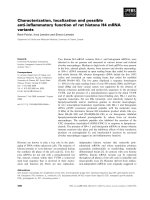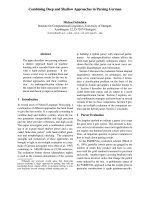Báo cáo khoa học: "The simple and the simpler in pneumonia diagnosis" pps
Bạn đang xem bản rút gọn của tài liệu. Xem và tải ngay bản đầy đủ của tài liệu tại đây (33.33 KB, 2 trang )
Page 1 of 2
(page number not for citation purposes)
Available online />Abstract
In the absence of a perfect ‘gold standard’ for diagnosing pneumonia,
comparing diagnostic performance between techniques remains
controversial. El Solh and coworkers present a study evaluating
use of quantitative endotracheal aspirate culture to enhance
diagnostic accuracy in pneumonia patients admitted from nursing
homes. We discuss the use of quantitative cultures and thresholds
to differentiate between colonization and infection in pneumonia
patients; we also consider the inaccuracy of diagnostic studies,
which compromises the reproducibility of these data in clinical
practice.
El Solh and coworkers [1] present an interesting study in
which they evaluated use of quantitative endotracheal
aspirate (QEA) cultures as a diagnostic tool for determining
presence of pneumonia in ventilated patients admitted from
nursing homes. The 2005 American Thoracic Society (ATS)/
Infectious Disease Society of America (IDSA) guidelines [2]
recommend that the approach to such patients should be like
that in patients with ventilator-associated pneumonia (VAP).
One of the strengths of this study is that it evaluates this
specific population. The study compared the diagnostic
accuracy of QEA with that of protected specimen brush
(PSB) and bronchoalveolar lavage (BAL). Unfortunately, the
impact of the findings on antibiotic therapy and patient
outcomes was not assessed. Other potential limitations not
discussed in the report include the lack of evaluation of QEA
sample quality, which is a major problem in interpretation of
study findings [3], and failure to consider the influence of co-
morbidities such as chronic obstructive pulmonary disease
(COPD).
The study shows that bacterial counts obtained through QEA
correlate with those obtained by PSB (r = 0.71) and BAL
(r = 0.77). However, Table 2 highlights an important weak-
ness of aetiological diagnosis based on a threshold;
Staphylococcus aureus was isolated in 50% more cases in
BAL samples as compared with PSB samples, using the
recommended threshold. Furthermore, the authors construc-
ted receive operating characteristic (ROC) curves to evaluate
the diagnostic accuracy of QEA, and found a sensitivity of
90% and a specificity of 77% when 10
4
colony-forming
units/ml was used as the diagnostic threshold. The threshold
of 10
4
colony-forming units/ml is lower than thresholds
recommended by IDSA/ATS [2] to differentiate colonization
from infection in QEA cultures. Therefore, what threshold
should be used at the bedside?
Use of bacterial counts as a diagnostic threshold in pneu-
monia has been proposed to differentiate colonization from
infection [4]. It aims to avoid over-use of antibiotics in
patients with low bacterial counts on quantitative cultures,
defining a cut-off for pneumonia diagnosis. The main concern
about defining such a cut-off is methodological. The ROC
curve is a useful tool for evaluating performance and
accuracy of diagnostic tests, but construction of ROC curves
assumes that there is a gold standard [5,6]. In the absence of
a gold standard, the true accuracy of the diagnostic
procedures tested in VAP patients is unpredictable.
Nevertheless, Michaud and coworkers [7] found that patient
selection criteria have the greatest impact on evaluation of a
test’s performance in VAP patients. Moreover, heterogeneity
among diagnostic criteria and the lack of a gold standard for
VAP diagnosis that could be applied across the various
diagnostic studies may lead to several biases. Previous
antibiotic exposure and technical aspects of the diagnostic
tests used may also have an effect on reported accuracy.
Souweine and coworkers [8] recommended use of lower
thresholds on quantitative cultures in patients who have
recently started antibiotic therapy. However, whether
Commentary
The simple and the simpler in pneumonia diagnosis
Thiago Lisboa and Jordi Rello
Critical Care Department, Joan XXIII University Hospital. University Rovira & Virgili, Institut Pere Virgili, CIBERes Enfermedades Respiratorias, Carrer
Mallafre Guasch, 4 - 43007,Tarragona, Spain
Corresponding author: Jordi Rello,
Published: 15 June 2007 Critical Care 2007, 11:140 (doi:10.1186/cc5933)
This article is online at />© 2007 BioMed Central Ltd
See related research by El Solh et al., />ATS = American Thoracic Society; BAL = bronchoalveolar lavage; COPD = chronic obstructive pulmonary disease; IDSA = Infectious Disease
Society of America; PSB = protected specimen brush; QEA = quantitative endotracheal aspirate; VAP = ventilator-associated pneumonia.
Page 2 of 2
(page number not for citation purposes)
Critical Care Vol 11 No 3 Lisboa and Rello
thresholds maintain their discriminatory value in such patients
requires evaluation. Until proven otherwise, a strategy to rule
in or rule out the presence of pneumonia based on a bacterial
count threshold has not been adequately tested and should
not be routinely used to make decisions regarding
antimicrobial treatment.
Whether use of quantitative cultures of lower respiratory tract
secretions has a diagnostic role to play remains controversial.
ATS/IDSA guidelines [2] recommend that quantitative
cultures should be performed on endotracheal aspirates or
samples collected bronchoscopically, and the choice of
method depends on local expertise, experience, availability
and cost. However, Heyland and coworkers [9] recently
reported, in a randomized multicentre clinical trial, that an
invasive bronchoscopy based strategy and a noninvasive non-
quantitative endotracheal aspirate culture based one were
associated with similar clinical outcomes and antibiotic use.
The best available evidence suggests that the clinical data
are insufficient to establish a definite diagnosis of pneumonia.
Culture of pulmonary secretions may help to refine the
physician’s clinical suspicion [10], but it should not be used
alone to confirm or refute it. Microbiologic findings can help
to tailor the antibiotic spectrum in selected patients, although
they should not be considered alone but rather with
reassessment of clinical response at 48 to 72 hours after
onset of pneumonia [11].
Albert Einstein (1879-1955) once stated that, ‘Things should
be made as simple as possible, but not simpler’. The dualism
of colonization versus infection that results from use of a
single cut-off to define pneumonia may represent an
oversimplification of a complex phenomenon. Exclusion of the
presence of pneumonia based simply on a ‘magic’ number, as
a simpler way to approach diagnosis, is a dangerous policy.
We should avoid being caught in this trap, because by
oversimplifying the diagnostic process in this way we take on
significant risk for mistreating (over or under) our patients.
Efforts should be focused on implementing bundles of
measures based on best evidence for diagnosis and treat-
ment, integrating clinical features and microbiology data, in
order to obtain a simple and effective approach to
management of pneumonia.
Competing interests
The authors declare that they have no competing interests.
Acknowledgement
Supported by Fondo de Investigaciones Sanitárias (PI05/2410),
CIBERes Enfermedades Respiratórias (CIBER 06/06/0036) and
MARATOTV3.
References
1. El Solh AA, Akinussi ME, Pineda LA, Mankowski CR: Diagnostic
yield of quantitative endotracheal aspirates in patients with
severe nursing-home acquired pneumonia. Crit Care 2007,
11:R57.
2. American Thoracic SocietyL Guidelines for the management of
adults with hospital-acquired, ventilator-associated, and
healthcare-associated pneumonia. Am J Respir Crit Care Med
2005, 171:388-416.
3. Gallego M, Rello J: Diagnostic testing for ventilator-associated
pneumonia. Clin Chest Med 1999, 20:671-679.
4. Fagon JY, Rello J: Targeted antibiotic management of ventila-
tor-associated pneumonia. Clin Microbiol Infect 2006, Suppl 9:
17-22.
5. Zou KH, O’Malley AJ, Mauri L: Receiver-operating characteristic
analysis for evaluating diagnostic tests and predictive
models. Circulation 2007, 115:654-657.
6. Irwig L, Bossuyt P, Glazsiou P, Gatsonis C, Lijmer J: Evidence
base of clinical diagnosis: designing studies to ensure that
estimates of test accuracy are transferable. BMJ 2002, 324:
669-671.
7. Michaud S, Suzuki S, Harbarth S: Effect of design-related bias
in studies of diagnostic tests for Ventilator-associated pneu-
monia. Am J Respir Crit Care Med 2002, 166:1320-1325.
8. Souweine B, Veber B, Bedos JP, Gachot B, Dombret MC,
Regnier B, Wolff M: Diagnosis accuracy of protected specimen
brush and bronchoalveolar lavage in nosocomial pneumonia:
impact of previous antimicrobial treatments. Crit Care Med
1998, 26:236-244.
9. The Canadian Critical Care Trials Group: A randomized trial of
diagnostic techniques for ventilator-associated pneumonia. N
Engl J Med 2006, 355:2619-2630.
10. Klompas M: Does this patient have ventilator-associated
pneumonia? JAMA 2007, 297:1583-1593.
11. Vidaur L, Gualis B, Rodriguez A, Ramirez R, Sandiumenge A,
Sirgo G, Diaz E, Rello J: Clinical resolution in patients with sus-
picion of ventilator-associated pneumonia: a cohort study
comparing patients with and without acute respiratory dis-
tress syndrome. Crit Care Med 2005, 33:1248-1253.
